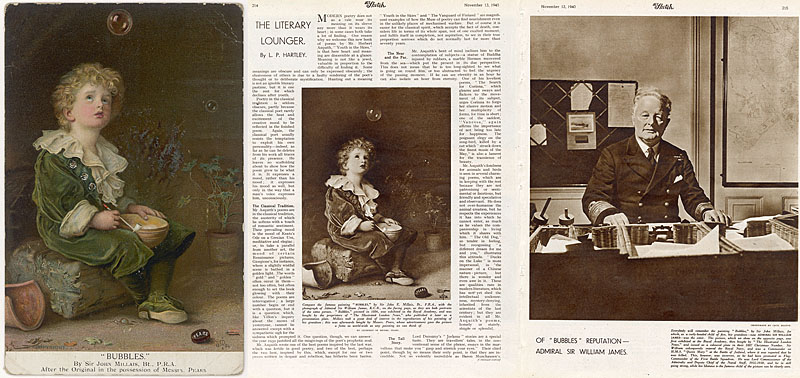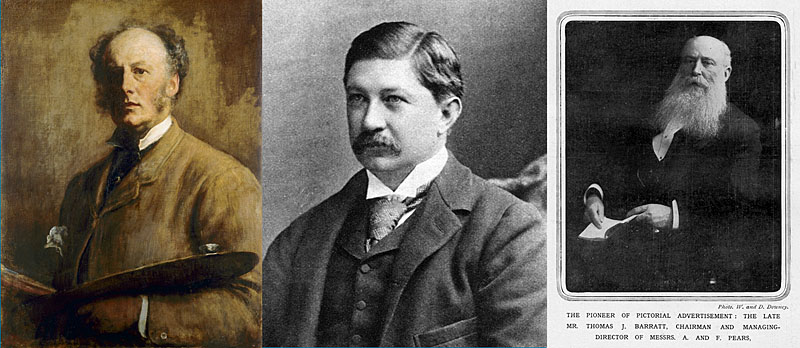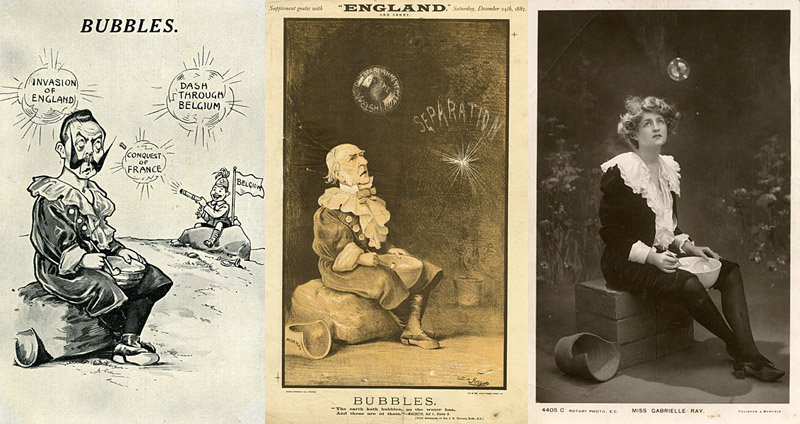 |
 |
 |

| If this email doesn't display properly, please click here. |
|  |

| Picture Story: The Boy who was Bubbles |
This week, we're introducing a new style of newsletter into our regular stable of missives. We'll continue to keep you updated with thematic ideas and collection news, but 'Picture Story' aims to give closer focus to stories we uncover within the archive - in bite-size form. We might concentrate on one image, or a handful; it may be something that would be otherwise overlooked in our usual newsletter format or an object with a surprising back story. Either way, we hope you enjoy these snippets of archival discovery and perhaps occasionally learn something you didn't know. |
When Sir John Everett Millais painted 'Bubbles' in 1886 he had long abandoned his rebel Pre-Raphaelite days, becoming a highly-paid and respectable member of the art establishment; a member of the Royal Academy since 1863, and created a baronet in 1885. His subjects were often children, and he unashamedly played to the Victorian appetite for sentimentality. Nevertheless, 'Bubbles' was intended as a serious work, with the bubbles (rather bleakly) representing the transience of life. 'Bubbles' was soon purchased by William Ingram, proprietor of The Illustrated London News and the paper released the picture as a presentation print "in the finest chromo-lithography" for its 1887 Christmas number. Ingram then sold the painting to Thomas Barratt, managing director of A. & F. Pears, along with the copyright. Barratt had immediately seen its very pertinent potential and a few tweaks, including a carefully placed bar of soap, turned the picture into an advertiser's dream. |
 |
|
Millais was among a number of eminent Academicians whose work was beginning to be used in the world of advertising, in what were the first steps towards what became known as the 'artistic poster' where attractive images and a snappy slogan (rather than dense letterpress), conveyed the marketing message to the passing public. As poster art became more sophisticated towards the end of the nineteenth century, the advertising hoardings soon became dubbed, 'the poor man's picture gallery'. But the exploitation of art by the commercial world raised more than a few disdainful eyebrows. Marie Corelli, the novelist, famously accused Millais of prostituting his talent to sell soap, writing, 'I get inwardly wrathful whenever I think of your 'Bubbles' in the hands of Pears as a soap advertisement! Gods of Olympus!' Having sold his painting, and the copyright, there was little Millais could do about it and simply had to accept that the adoption of 'Bubbles' by Pears had assured its place in the public consciousness. A true test of any picture's reach is when it is used as inspiration for popular cartoons and sure enough, cartoonists lampooned public figures from Gladstone to the German Kaiser in what were an unmistakeable pastiche of the famous Pears Soap advert. Even popular stage actress Gabrielle Ray posed as 'Bubbles' in a photograph that was published as a postcard. |
 |
|
As an addendum to this story, we were reminded last week, that the boy in the original painting was in fact Millais's four-year-old grandson, when we came across a photograph of Admiral Sir William James (1881-1973) in The Sketch, 1940. His portrait, by Cecil Beaton, was juxtaposed with a reproduction of the famous painting on the opposite page, and despite the passage of fifty-four years, the mop top of curls was clear proof that we were indeed looking at the same person. Sir William, who had a long and illustrious naval career, also appears on a 1914 cover of the Sunday Pictorial alongside the painting. How he felt about being the face of Victorian consumerism is anyone's guess, though he endured the nickname 'Bubbles' for the rest of his life. Today, for anyone wishing to look and ponder upon Millais's famous painting, it hangs in the Lady Lever Art Gallery in Port Sunlight. As a gallery built upon the profits from soap, there cannot surely be a better venue to see a picture that so perfectly epitomises the uneasy marriage between art and commerce. Click here to see a wider selection of images relating to this story. Get in touch to find out how we can help you tell your story. For quotes, queries and picture research requests, email [email protected] or call us on 020 8318 0034. |
| Mary Evans Picture Library Ltd. 59 Tranquil Vale Blackheath London SE3 0BS. United Kingdom. |
| Unsubscribe here |